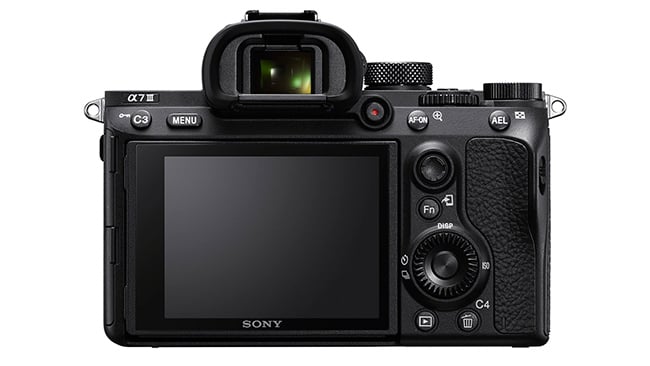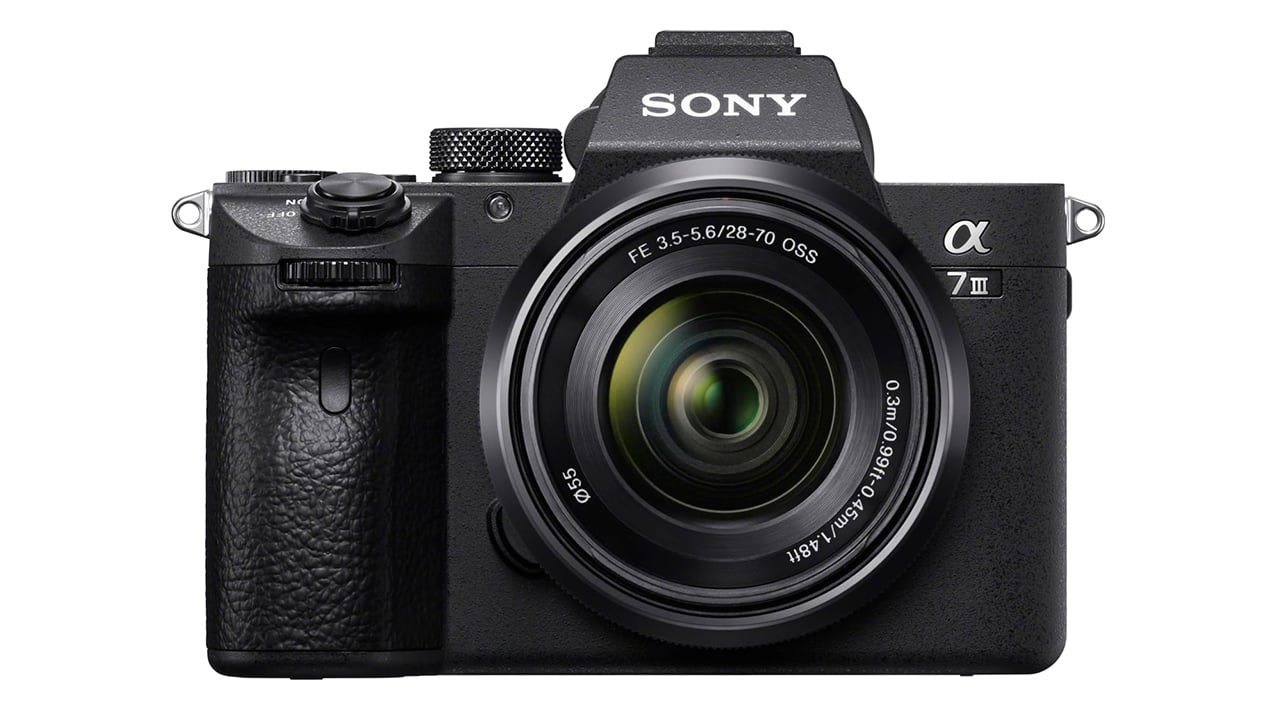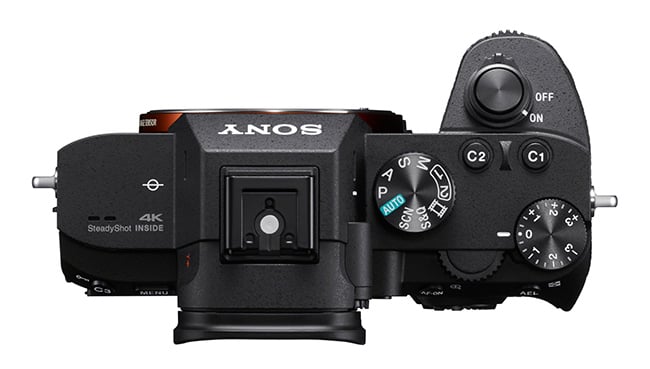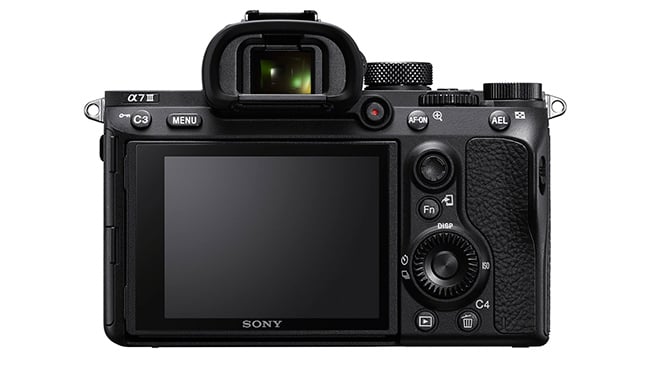
 The long awaited Sony α7III
The long awaited Sony α7III
With 4K video downsampled from 6K over the full sensor width, Sony's new α7III offers some incredibly compelling capabilities and features that are sure to give the competition some rather hot collars.
It has been a rather busy time this week as one by one a new camera or imaging product is seemingly announced every hour. Today is no exception with the official announcement of the hotly anticipated Sony α7III.
It is fair to say that the α7 series is now practically legendary. Each version offering best in class capabilities for its time. None more so than the S variations, which have become renowned for their low light shooting abilities.
Full-frame sensor
At the heart of the α7III is a brand new 24.2MP full-frame back illuminated Exmor R CMOS sensor, which in its expanded ISO mode offers a range from 50-204800. Sony is also claiming a 15 stop dynamic range, albeit at lower sensitivities. This is, apparently 1.5 stops better than the previous model.
On paper then, a bit of a performer. But what stands out is when we look at the video modes. The camera reads from the full width of the sensor with no pixel binning. In effect the camera is achieving 4K video by downsampling from a smidgen over 6K worth of data with no windowing. Needless to say that this could well result in some very nice video indeed.
As per most new cameras these days, HLG is fully catered for, as well as the ability to shoot with Slog2 and 3. The α7III is also capable of shooting 120fps in 1080p mode with a 100Mbps bitrate. Proxy recording is another feature that offers flexibility for dealing with the footage in post. Is the footage 8-bit or 10-bit? We don’t have the details, but we would presume that the α7III remains in the 8-bit realm.

Stills capabilities
When it comes to stills, which is after all the primary purpose of such a camera, the α7III is hardly a slouch here either. The same technology that allows it to record such high quality video also allows it to capture full resolution raw stills at up to 10fps. This can be done with either the mechanical shutter or in its silent mode. Note, though, that this is only available for short bursts. For continuous shooting it can be placed in live view mode where it achieves 8fps
Another interesting feature I noted was that the camera can use an anti-flicker setting automatically detect lighting frequency, which can cause issues at certain shutter settings.
Autofocus
The different manufacturers are now heavily competing when it comes to autofocus capabilities. At one time derided, autofocus systems have made huge progress in recent years.
On the α7III Sony are touting its 4D FOCUS capabilities. This translates, in the words of Sony into “425 contrast AF points that work with a 693-point focal-plane phase-detection AF system inherited from the acclaimed α9 model”. The new camera also features a 5-axis in-body optical stabilisation system, giving a claimed 5-stop advantage.
Sony is claiming that the new system is capable of twice the speed of the previous camera.
Build wise the rear of the the camera houses an OLED viewfinder, and the usual large flip out touch screen display. But there’s one other surprise in the form of two SD card slots. These can be configured so that you can record separate JPEG and RAW files, or have stills on one card and video recorded to the other. Or simply use them as a relay system for extra capacity. Sony also claims that the NP-FZ100 battery gives a vastly improved life over the previous version of the camera.

Why consider the α7III?
The question remains then, what does this camera do that the α7RIII doesn't?
While the α7III has less sensor resolution than the α7RIII (24MP vs 42MP), the new camera has a higher sensitivity, most likely due to larger photosites. For those who are more interested in the video modes it is also worth noting that the α7III samples the full sensor width before downsampling. Whilst it is true that the α7RIII also oversamples for video, it windows the sensor to Super35 dimensions before it does so. This means that if you want to retain the full-frame look for video, the α7III will be the one to go to. Lastly, the new camera is over £1000 less to buy. A compelling reason if ever there was one, especially if you you do not require the almost medium format 42MP stills resolution of the R.
The α7III looks to be a pretty nice upgrade over the old model by any stretch of the imagination, and if there is one thing for certain in all of this, it means that no matter where you are in the world, there’s a camera that will fit into your pocket or a small bag that allows you to record extremely high quality 4K video. Not just passable video, but truly usable footage that can be projected onto a big screen with ease. It’s a cliche to say it, but these are interesting times indeed!
The α7III will be available from March at a price of £2000 for the body only, or £2300 with a kit lens bundle.
Full press release follows on the next page.
Sony expands “Full-frame Mirrorless” line-up with new a7 III with the latest imaging technologies all compressed into a compact package
Press Release • Feb 27, 2018 01:17 GMT
- Newly Developed Full-frame 24.2MPi Back-Illuminated Exmor R™ CMOS Image Sensor with Evolved Image Processing
- Wide ISO range of 100 - 51200 (expandable to ISO 50 – 204800 for still images) and 15-Stopii Dynamic Range at low sensitivities
- World Class AF system featuring 693 phase-detection AF points covering 93% of image area, 425 contrast AF points and fast and reliable Eye AF
- Continuous Shooting at up to 10 fpsiii with either Mechanical Shutter or Silent Shooting[iv] and full Auto Focus/Auto Exposure tracking
- 5-axis optical in-body image stabilisation with a 5.0 stepv shutter speed advantage
- High Resolution 4K[vi] Movie Shooting with full pixel readout and no pixel binning across full-width of full-frame sensor
- The longest rated battery life of any Mirrorless cameravii at 710 shots[viii] per charge
- Upgraded operability and functionality including addition of joystick for adjusting focus points, Dual SD Card Slots, SuperSpeed USB (USB 3.1 Gen 1) USB Type-C™ Terminal and more
- Sony today introduced yet another impressive addition to their full-frame mirrorless camera line-up, the α7 III (model ILCE-7M3).
Sony’s unmatched innovation within the image sensor space is at the forefront of the new α7 III, as it features a brand new 24.2MPi back-illuminated Exmor R CMOS image sensor with increased sensitivity, outstanding resolution and an impressive 15 stopsii of dynamic range at low sensitivities. By combining this sensor with a variety of impressive features including extreme AF coverage of 93%, fast shooting at up to 10 fpsiii with either mechanical shutter or silent shootingiv, diverse 4Kvi video capabilities and more, Sony has created a new tool that gives all types of creators – from enthusiast to professional – the ability to capture content in new and different ways than they ever have before.
Spectacular Full-frame Image Quality
The newly developed 24.2MPi back-illuminated Exmor R CMOS image sensor is paired with a front-end LSI that effectively doubles the readout speed of the image sensor, as well as an updated BIONZ X™ processing-engine that boosts processing speed by approximately 1.8 times compared to the α7 II. These powerful components work together to allow the camera to shoot at faster speeds while also enabling its impressive ISO range of 100 - 51200 (expandable to ISO 50 – 204800 for still images) and an overall 1.5-stopix improvement in image quality. The camera also features a massive 15-stopii dynamic range at low sensitivity settings, ensuring outstanding overall performance at all settings and in all shooting conditions, with significant advancements in accurate colour reproductions of skin tones and the vibrant colours of nature.
This new full-frame model can also output 14 bit RAW formatx even in silent and continuous shooting modes, and is equipped with a 5-axis optical image stabilisation system that results in a 5.0 stepv shutter speed advantage.
Significant Advances in AF Speed and Performance
The innovative new α7 III full-frame mirrorless camera features a level of AF performance that has been largely improved over the α7 II, including the addition of 4D FOCUS™ capabilities. The new camera has 425 contrast AF points that work with a 693-point focal-plane phase-detection AF system inherited from the acclaimed α9 model. This innovative AF system covers approximately 93% of the frame, ensuring reliable focusing and tracking for even the most difficult to capture subjects.
AF response and tracking has also been greatly improved in the new camera, with almost 2xix the focusing speed in low-light condition and 2xii the tracking speed compared to the previous model as a result of the faster image sensor readout. This allows complex and unpredictable motion to be captured with far greater precision and accuracy.
The acclaimed Eye AF feature is also available in the new camera, even in AF-C mode, which is extremely useful for situations where the subject is turning around, looking down or otherwise obstructed. It also works when the α7 III is being used with Sony’s A-mount lenses with an optional LA-EA3 adaptorxi. Additional improvements in focusing flexibility include the addition of a multi-selector or ‘joystick’ for moving focusing points quickly, the addition of touch focusing capability, AF availability in Focus Magnifier mode, an ‘AF On’ button and much more.
Speed to Capture Every Decisive Moment
The new α7 III is equipped with an updated image processing system that allows it to shoot full resolution images at up to 10 fpsiii with continuous, accurate AF/AE tracking for up to 177 Standard JPEG images, 89 compressed RAW images or 40 uncompressed RAW imagesxii. This high speed mode is available with either a mechanical shutter or a completely silent shootingiv, adding to the immense flexibility of the camera. The camera can also shoot continuously at up to 8 fpsiii in live view mode with minimal lag in the viewfinder or LCD screen.
For added convenience, while large groups of burst images are being written to the memory card, many of the cameras key functions are operable, including access to the ‘Fn’ (Function) and ‘Menu’ buttons, image playback and several other menus and parameters including image rating and other functions that facilitate on-location image sorting.
Additionally, if there is fluorescent or artificial lighting present in a shooting environment, users can activate the Anti-flickerxiii function to allow the α7 III to automatically detect frequency of the lighting and time the shutter to minimise its effect on images being captured. This minimises any exposure or colour anomalies that can sometimes occur at the top and bottom of images shot at high shutter speeds.
High Quality 4Kvi Video
The new α7 III is an outstanding video camera as well, offering 4Kvi (3840x2160 pixels) video recording across the full width of the full-frame image sensor. In video mode, the camera uses full pixel readout without pixel binning to collect about 2.4xxiv the amount of data required for 4K movies, and then oversamples it to produce high quality 4K footage with exceptional detail and depth.
An HLG (Hybrid Log-Gamma)xv picture profile is available on the α7 III as well, which supports an Instant HDR workflow, allowing HDR (HLG) compatible TV’s to playback beautiful, true-to-life 4K HDR imagery. Further, both S-Log2 and S-Log3 are available for increased colour grading flexibility, as well as Zebra functionality, Gamma Display assist and proxy recording. The camera can also record Full HD at 120 fps at up to 100 Mbpsvi, allowing footage to be reviewed and eventually edited into 4x or 5x slow motion video files in Full HD resolution with AF tracking.
Upgraded Build, Design and Customisation
Sony’s newest full-frame camera is equipped with a variety of enhanced capabilities that were first implemented in the α9 and then again in the α7R III. These include dual media slots, with support in one slot for UHS-II type SD memory cards. Users have a variety of options for storing their content in each of the cards, including separate JPEG / RAW recording, separate still image / movie recording, relay recording and more. Battery life has been greatly extended as well – with a CIPA measurement of up to 710 shots per chargeviii, it offers the world’s longestvii battery life of any Mirrorless camera, as the new camera utilises Sony’s Z series battery NP-FZ100 that offers approximately 2.2 times the capacity of the W series battery NP-FW50 utilised in the α7 II.
The new camera features “My Menu” functionality which allows up to 30 menu items to be registered for instant recall when needed. Users can also apply star ratings to their still images through the camera controls for easier image playback and review, and edit the first three characters of all still image files. Additionally, there is a total of 81 functions that are assignable to 11 custom buttons, and the camera is both dust and moisture resistantxvi.
The α7 III features high-resolution, high-contrast, fast-start XGA OLED Tru-Finder™ with approximately 2.3 million dots for extremely accurate, true-to-life detail reproduction. “Standard” or “High” display quality settings are also available for both the viewfinder and monitor as well. It also is capable of seamlessly transferring files to a smartphone, tablet, computer or FTP server via Wi-Fi®, while also offering a SuperSpeed USB (USB 3.1 Gen 1) USB Type-C™ Terminal for increased flexibility in power supply and faster image transfer speed during tethered shooting.
The α7 III model also comes with Sony’s new software suite “Imaging Edge”, which extends the creative capabilities of the entire shooting process – from pre-processing to post-processing. “Imaging Edge” provides three PC applications called ‘Remote’, ‘Viewer’ and ‘Edit’, available for free download, which support live-view PC remote shooting and RAW development. In the latest Version 1.1, several improvements have been implemented including about 10%xvii faster data transfer speed for remote shooting from PC (PC tether shooting) and approximately 65%xviii improvement in the response speed for RAW image editing. For more information, please visit Imaging Edge support page. www.sony.net/disoft/d/.
The camera is also compatible with a wide variety of Sony E-mount accessories including the BC-QZ1 Battery Chargerxix, VG-C3EM Vertical Grip.
The new α7 III will ship in Europe in March, 2018 priced at approximately £2,000 / €2,300 (body only) or £2,200/ €2,500 in a kit with the SEL2870 lens.
A variety of exclusive stories and exciting new content shot with the new α7 III camera and other Sony α products can be found at www.alphauniverse.com, a site built to educate and inspire all fans and customers of the Sony α brand.
The new content will also be posted directly at the Sony Photo Gallery and the Sony Camera Channel on YouTube.
[i] Approximate, effective
[ii] Sony test conditions for still images
[iii] In continuous “Hi+” mode. Max. fps depends on camera settings
[iv] Some distortion may occur with fast-moving subjects
[v] CIPA standards. Pitch/yaw shake only. Planar T* FE 50mm F1.4 ZA lens. Long exposure NR off
[vi] A Class 10 or higher SDHC/SDXC memory card required for XAVC S movie recording, UHS speed class 3 or higher for 100 Mbps recording
[vii] Among non-reflex interchangeable lens digital camera equipped with auto focus functionas of February 2017, based on Sony research
[viii] CIPA standards. When using the LCD monitor. 610 images when using the viewfinder
[ix] Compared to the α7 II. Sony test conditions
[x] Limited to 12 bits during compressed RAW continuous shooting, BULB exposure, or when Long Exposure NR is ON
[xi] With SSM or SAM lenses only. With the LA-EA3 mount adaptor. Eye AF not supported for movie recording. AF-C can only be used when the “Phase detection” AF system is selected, but focus is fixed at the first frame
[xii] Continuous “Hi+” mode. UHS-II compatible SDXC memory card required. Sony test conditions
[xiii] Only 100 Hz and 120 Hz flicker is detected. Continuous shooting speed may decrease. Flicker-free shooting is not available during silent shooting, BULB exposure, or movie recording
[xiv] 24p recording. Approx. 1.6x at 30p
[xv] Connect to an HDR (HLG) compatible Sony TV via a USB cable to view HDR (HLG) movies
[xvi] Not guaranteed to be 100% dust and moisture proof
[xvii] The transfer speed has been measured with multiple images using α7R III, SuperSpeed USB (USB 3.1 Gen 1), and Uncompressed RAW ( L: 7952 x 5304)+JPEG Extra fine
[xviii] Measured with: CPU Intel® Core™ i7-6700 Processor 3.40GHz, Memory 8GB, OS Windows® 7 Professional, and Uncompressed RAW (α7R III L: 7952 x 5304)
[xix] Not supplied in the box
Tags: Production



Comments